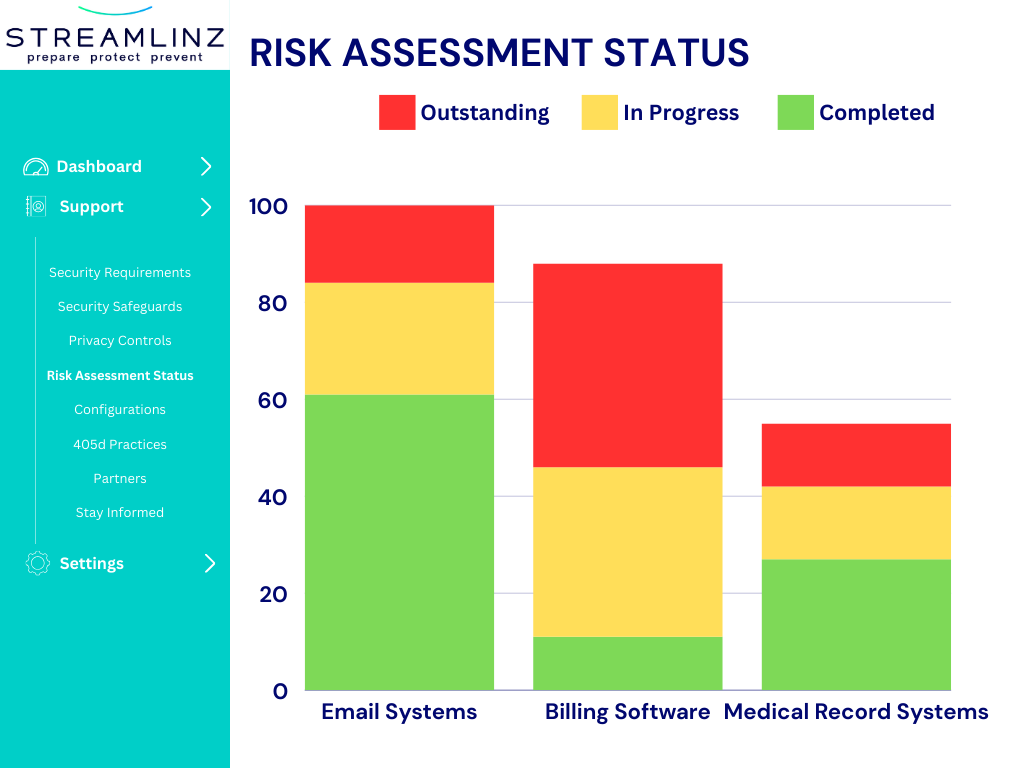Why a NIST based solution?
Cybersecurity best practices require a NIST based solution that follows OCR audit protocol. NIST and their Cyber Security Protocol (CSF) is what we follow in the Streamlinz Risk Analysis.

What is the NIST CSF
Many groups claim best practices for cybersecurity, but they are long and difficult to understand. The CSF breaks down the cyber risks and makes its management easier, to allow for immediate remediation. It simplifies the language of cybersecurity so that everyone can understand and move quickly toward compliance.
The core functions of the NIST CSF include:
Identify: The Identify function helps you to develop an overall risk management approach to cybersecurity. It helps you understand your critical assets, business environment, governance model, and vendors/suppliers in your environment.
Protect: Protect helps you determine what controls need to be in place based on your critical assets, risk tolerance, and other input that has been identified. Key aspects of this function are securing access, protecting data, and ongoing education of stakeholders.
Detect: Attacks can come at any time and may not be initially apparent. By having the proper policies in place, this function shortens the time to discovery by spotting anomalies, investigating events, and continuous monitoring.
Respond: Responding quickly via incident response planning, analysis, mitigation, and communication is key to minimizing disruption and costs.
Recover: After an incident, the recover function helps you restore operations through recovery planning, continuous improvement, and communications.
Let's get started protecting your assets
Base Plan
Offering Includes:
Core Protection
Risk Assessment
- Privacy Review
- Security Review
405 (d) HICP Review
- Automated Task Reminders
- Remediation History
- Yearly Assessments
- Custom Reporting
- Education Sessions
Predictive Risk Calculations
Policy and Procedure Library
- Industry Updates
Protection Plan
Offering Includes:
Full Protection
- Risk Assessment
- Privacy Review
- Security Review
405 (d) HICP Review
- Automated Task Reminders
- Remediation History
- Yearly Assessments
- Custom Reporting
- Education Sessions
- Predictive Risk Calculations
Policy and Procedure Library
- Industry Updates
Complete Plan:
Offering Includes:
Exceptional Protection
- Risk Assessment
- Privacy Review
- Security Review
- 405 (d) HICP Review
- Automated Task Reminders
- Remediation History
- Yearly Assessments
- Custom Reporting
- Education Sessions
- Predictive Risk Calculations
- Policy and Procedure Library
- Industry Updates
Contact Us
949.994.9689 (Phone)
support@streamlinz.com
Our Solutions
Company
Subscribe to our intelligence feeds
Receive ongoing updates on industry news and trends.
Contact Us
Thank you for subscibing to our compliance notifications. Get ready for educational information to keep you updated on the compliance industry.
Please try again later.
All Rights Reserved | Streamlinz LLC